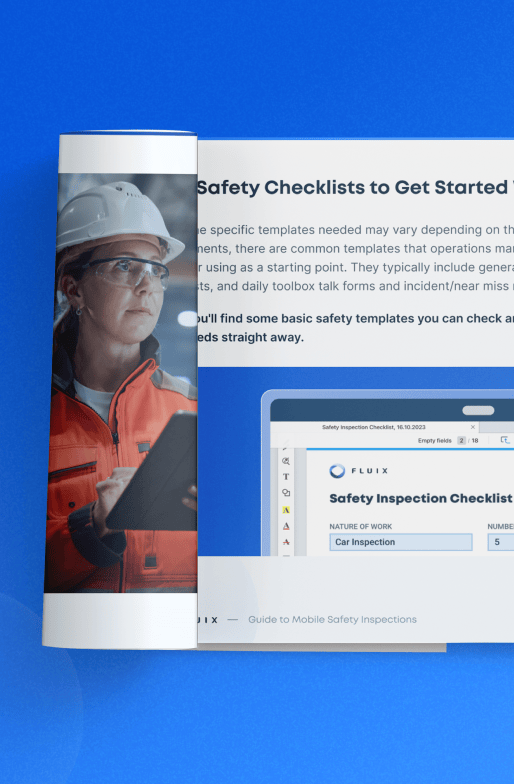To keep your organization efficient and productive, staying abreast of emerging health and safety trends is essential.
This article explores five key trends shaping the future of field service businesses globally, revealing strategies, technologies, and practices that can help you navigate challenges.
Contents:
1. Mobile Tech for Data Collection
Field service businesses often face unique health and safety challenges due to the nature of their work. They include, among others, hazards, delayed incident reporting, equipment safety, and emergency response planning.
Mobile data collection can be an efficient solution to these challenges thanks to the widespread use of smartphones and tablets in the field, advancements in mobile apps, and connectivity options for remote workforce.
One of the ways it does it is by facilitating real-time incident reporting. Field service teams can instantly capture and document accidents, injuries, and near misses using mobile devices, enabling prompt responses.
Other usages of mobile data collection that make it a big health and safety trend:
- Enhancing the quality and reliability of safety data.
- Conducting risk assessments and implementing preventive actions in real-time.
- Effective communication between field workers and management for better operational efficiency.
- Protection of sensitive field health and safety data.
With increased awareness of data and privacy concerns, modern software is designed with robust security measures, including encryption, authentication, and secure transmission protocols. These tools protect sensitive information while enabling instant safety reporting.
The Ultimate Guide
to Safety Inspections
Checklists, tools, and best practices to help you meet the safety regulations for your industry and don’t risk fines


2. Sustainability
There has been a strong push toward data-driven safety in compliance practices for a while now. However, as sustainability regulations spread globally, there’s also a growing focus on integrating green practices into every facet of an organization.
It’s not just governmental policies driving this change: banks and investors are now closely examining a company’s environmental, social, and governance (ESG) performance when deciding on financing. Winning new bids can even depend on having strong sustainability practices.
As a result, merging sustainability with health and safety efforts is now essential for staying competitive and securing new opportunities.
This growing workplace safety trend involves adopting green practices to enhance worker protection. Some examples include:
- Using non-toxic, biodegradable cleaning agents.
- Practicing efficient waste management, like recycling construction debris.
- Adopting LED lighting and portable renewable energy units.
- Investing in sustainable safety equipment.
By proactively identifying worksite hazards and addressing them through sustainable measures, businesses can foster more secure work environments and benefit the planet simultaneously.
This approach not only meets regulatory requirements but also builds a resilient, future-ready organization.
3. Climate-Induced Risk Management Strategies
Although field ops are used to braving the elements, in recent years, there’s been a rise in extreme weather events, such as heatwaves, storms, and increased rainfall.
Extreme weather can cause physical damage to infrastructure on sites, which can pose immediate risks to employee safety. This danger can present in several ways, such as structural weaknesses, slippery floors, or blocked emergency exits.
Electricity, water supply, and communication networks can also be damaged by the weather. This can impact the functionality of equipment and operational systems, and even prevent contact with emergency services.
To mitigate these risks, it’s essential to have the appropriate health and safety management system and checks in place.
This includes:
- Establishing clear protocols for extreme weather situations and ensuring employees are aware of them.
- Regularly maintaining workplace infrastructure and inspecting equipment to minimize risks associated with unpredictable weather conditions.
- Providing employee training on emergency procedures, first aid, and hazard recognition.
By fostering a culture of safety and implementing the necessary technologies and processes, workplaces can better protect their employees during periods of intense weather.
4. Mental Health Awareness
Increased mental health awareness in the workplace is a growing health and safety trend.
Now, more than ever, employers across sectors are prioritizing employee emotional well-being. This shift can be attributed in part to the consequences of the COVID pandemic.
Within construction and engineering, 45% of workers have taken time off work due to mental health. Also, figures in the aviation industry are alarming, with more than 12% of pilots experiencing depression.
Implementing innovative digital solutions can go a long way to improving access to support in the workplace.
This can include:
- Apps to support mental well-being.
- Online counseling and therapy sessions.
- Wellness platforms.
- Peer support networks.
Specially designed occupational safety software allows professionals to implement automated processes for risk assessment and welfare management.
These processes can be used for a variety of reasons, including employee well-being and harm prevention.
5. Robotics
Robots have been part of workplaces for years. Now, they’re taking on even more roles, working alongside us, moving around job sites, and being worn by workers.
Recognizing the importance of these advancements, the Centers for Disease Control and Prevention (CDC) established the Center for Occupational Robotics Research. This new center explores how robots can enhance worker safety, while possibly maintaining safety compliance.
In field service operations, robots are increasingly used to perform hazardous tasks, thereby protecting workers. This includes:
- Inspecting and maintaining electrical lines and poles.
- Checking underground pipes for damage or leaks.
- Managing and disposing of hazardous waste.
- Cleaning solar panels.
One major barrier to fully embracing this safety trend is the cost and complexity of developing and maintaining robots. That’s where we’re starting to see Robotics-as-a-Service (RaaS) make a difference.
With RaaS, companies can lease robots on a subscription basis, allowing them to scale operations up or down as needed. This model eliminates hefty upfront costs, making advanced robotics more accessible to businesses of all sizes. In 2024, we expect more companies to adopt robotic technologies thanks to this flexibility.
However, to maximize the benefits of these technologies, it’s crucial to prioritize communication for safety to prevent accidents and enhance collaboration.
Keeping on Top of Health and Safety Technology with Fluix
Fluix is workflow automation software that helps field service companies manage their health and safety activities more effectively with automated workflows and field data collection tools:
- Automated workflows replace traditional paper-based workflows, and health and safety documents can be easily created, accessed, and managed in a secure digital environment.
- The mobile app allows field service workers to capture and submit health and safety information in real-time using their mobile devices.
- The approval cycle is fully automated, with changes or updates to health and safety documents instantly communicated to relevant stakeholders.
By embracing these and other Fluix digital workflow solutions, you can enhance workplace safety, streamline operations, and improve overall efficiency.






